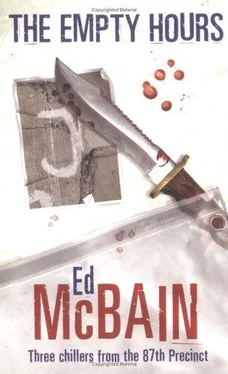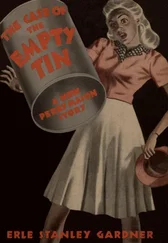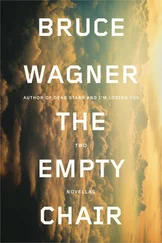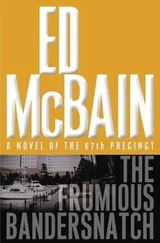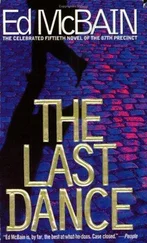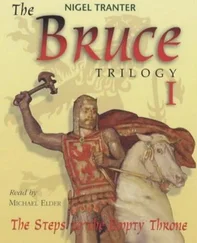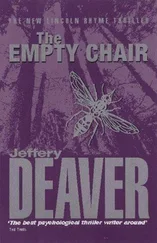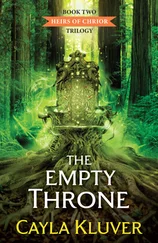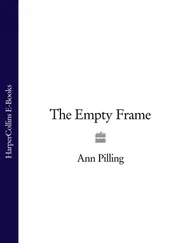The telephone rang. Meyer stopped speaking and looked at his wife. For a moment, both seemed reluctant to break the spell of the ceremony. And then Meyer gave a slight, barely discernible shrug. Perhaps, as he went to the telephone, he was recalling that he was a cop first, and a Jew only second.
“Hello?” he said.
“Meyer, this is Cotton Hawes.”
“What is it, Cotton?”
“Look, I know this is your holiday —”
“What’s the trouble?”
“We’ve got a killing,” Hawes said.
Patiently, Meyer said, “We’ve always got a killing.”
“This is different. A patrolman called in about five minutes ago. The guy was stabbed in the alley behind —”
“Cotton, I don’t understand,” Meyer said. “I switched the duty with Steve. Didn’t he show up?”
“What is it, Meyer?” Sarah called from the dining room.
“It’s all right, it’s all right,” Meyer answered. “Isn’t Steve there?” he asked Hawes, annoyance in his voice.
“Sure, he’s out on the squeal, but that’s not the point.”
“What is the point?” Meyer asked. “I was right in the middle of —”
“We need you on this one,” Hawes said. “Look, I’m sorry as hell. But there are aspects to — Meyer, this guy they found in the alley —”
“Well, what about him?” Meyer asked.
“We think he’s a rabbi,” Hawes said.
The sexton of the Isola Jewish Center was named Yirmiyahu Cohen, and when he introduced himself, he used the Jewish word for sexton, shamash. He was a tall, thin man in his late fifties, wearing a somber black suit and donning a skullcap the moment he, Carella and Meyer re-entered the synagogue.
The three had stood in the alley behind the synagogue not a moment before, staring down at the body of the dead rabbi and the trail of mayhem surrounding him. Yirmiyahu had wept openly, his eyes closed, unable to look at the dead man who had been the Jewish community’s spiritual leader. Carella and Meyer, who had both been cops for a good long time, did not weep.
There is plenty to weep at if you happen to be looking down at the victim of a homicidal stabbing. The rabbi’s black robe and fringed prayer shawl were drenched with blood, but happily, they hid from view the multiple stab wounds in his chest and abdomen, wounds which would later be examined at the morgue for external description, number, location, dimension, form of perforation and direction and depth of penetration. Since twenty-five per cent of all fatal stab wounds are cases of cardiac penetration, and since there was a wild array of slashes and a sodden mass of coagulating blood near or around the rabbi’s heart, the two detectives automatically assumed that a cardiac stab wound had been the cause of death, and were grateful for the fact that the rabbi was fully clothed. They had both visited the mortuary and seen naked bodies on naked slabs, no longer bleeding, all blood and all life drained away, but skin torn like the flimsiest cheesecloth, the soft interior of the body deprived of its protective flesh, turned outward, exposed, the ripe wounds gaping and open, had stared at evisceration and wanted to vomit.
The rabbi now owned flesh, too, and at least a part of it had been exposed to his attacker’s fury. Looking down at the dead man, neither Carella nor Meyer wanted to weep, but their eyes tightened a little and their throats went peculiarly dry because death by stabbing is a damn frightening thing. Whoever had handled the knife had done so in apparent frenzy. The only exposed areas of the rabbi’s body were his hands, his neck, and his face — and these, more than the apparently fatal, hidden incisions beneath the black robe and the prayer shawl, shrieked bloody murder to the night. The rabbi’s throat showed two superficial cuts which almost resembled suicidal hesitation cuts. A deeper horizontal slash at the front of his neck had exposed the trachea, carotids and jugular vein, but these did not appear to be severed — at least, not to the layman eyes of Carella and Meyer. There were cuts around the rabbi’s eyes and a cut across the bridge of his nose.
But the wounds which caused both Carella and Meyer to turn away from the body were the slashes on the insides of the rabbi’s hands. These, they knew, were the defense cuts. These spoke louder than all the others, for they immediately reconstructed the image of a weaponless man struggling to protect himself against the swinging blade of an assassin, raising his hands in hopeless defense, the fingers cut and hanging, the palms slashed to ribbons. At the end of the alley, the patrolman who’d first arrived on the scene was identifying the body to the medical examiner as the one he’d found. Another patrolman was pushing curious bystanders behind the police barricade he’d set up. The laboratory boys and photographers had already begun their work.
Carella and Meyer were happy to be inside the synagogue again.
* * *
The room was silent and empty, a house of worship without any worshipers at the moment. They sat on folding chairs in the large, empty room. The eternal light burned over the ark in which the Torah, the five books of Moses, was kept. Forward of the ark, one on each side of it, were the lighted candelabra, the menorah, found by tradition in every Jewish house of worship.
Detective Steve Carella began the litany of another tradition. He took out his notebook, poised his pencil over a clean page, turned to Yirmiyahu, and began asking questions in a pattern that had become classic through repeated use.
“What was the rabbi’s name?” he asked.
Yirmiyahu blew his nose and said, “Solomon. Rabbi Solomon.”
“First name?”
“Yaakov.”
“That’s Jacob,” Meyer said. “Jacob Solomon.”
Carella nodded and wrote the name into his book.
“Are you Jewish?” Yirmiyahu asked Meyer.
Meyer paused for an instant, and then said, “Yes.”
“Was he married or single?” Carella asked.
“Married,” Yirmiyahu said.
“Do you know his wife’s name?”
“I’m not sure. I think it’s Havah.”
“That’s Eve,” Meyer translated.
“And would you know where the rabbi lived?”
“Yes. The house on the corner.”
“What’s the address?”
“I don’t know. It’s the house with the yellow shutters.”
“How do you happen to be here right now, Mr. Cohen?” Carella asked. “Did someone call to inform you of the rabbi’s death?”
“No. No, I often come past the synagogue. To check the light, you see.”
“What light is that, sir?” Carella asked.
“The eternal light. Over the ark. It’s supposed to burn at all times. Many synagogues have a small electric bulb in the lamp. We’re one of the few synagogues in the city who still use oil in it. And, as shamash, I felt it was my duty to make certain the light —”
“Is this an Orthodox congregation?” Meyer asked.
“No. It’s Conservative,” Yirmiyahu said.
“There are three types of congregation now,” Meyer explained to Carella. “Orthodox, Conservative and Reform. It gets a little complicated.”
“Yes,” Yirmiyahu said emphatically.
“So you were coming to the synagogue to check on the lamp,” Carella said. “Is that right?”
“That’s correct.”
“And what happened?”
“I saw a police car at the side of the synagogue. So I walked over and asked what the trouble was. And they told me.”
“I see. When was the last time you saw the rabbi alive, Mr. Cohen?”
“At evening services.”
“Services start at sundown, Steve. The Jewish day —”
“Yes, I know,” Carella said. “What time did services end, Mr. Cohen?”
Читать дальше
